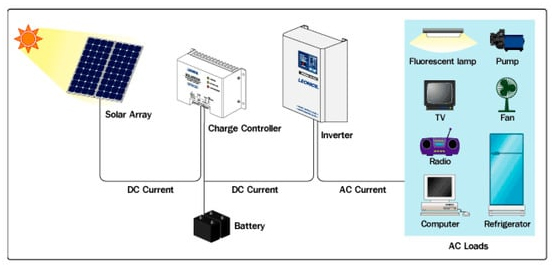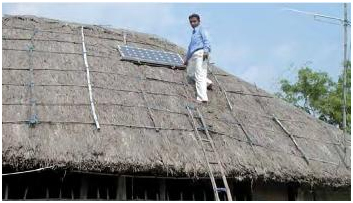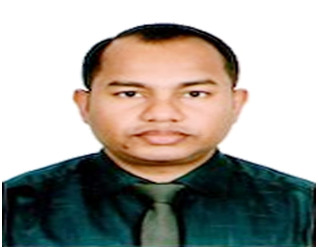Somiron Mistry
Published:2024-11-21 16:06:02 BdST
Future Prospect of Solar Home System (SHS) at Rural Areas in Bangladesh
Power is one of the most important factors in developing the economy and the standard of living of a country. Like the rest of the countries of the world, in Bangladesh the demand for power is increasing day by day.
To fulfil our future power demands, Solar Home System (SHS) seems to be the only feasible form of renewable energy despite the cloudy climate in Bangladesh.
The objective of the study was to observe the present conditions of the SHS, the degree of satisfaction experienced by the users of SHS, finding the prospects and constraints as well as contributing in the field of solar energy through presenting and highlighting important principles of solar energy.
Our study revealed the users' satisfaction level to be not that encouraging due to low back-up time, high cost and increased interest rate. If these hindrances are overcome, then this would show positive proliferation in the energy sector of Bangladesh.
Solar Home Systems (SHS) are stand-alone photovoltaic systems and converts solar energy to electricity that offer a cost-effective mode of supplying amenity power for lighting and appliances to remote off-grid households. There is a bright prospect of solar electricity in rural areas that are not connected to the grid, SHS can be used to meet a household's energy demand fulfilling basic electric needs.
Globally SHS provide power to hundreds of thousands of households in remote locations where electrification by the grid is not possible. SHS usually operate at a rated voltage of 12 V direct current (DC) and provide power for low power DC appliances such as lights, radios and small TVs for about three to five hours a day. Furthermore, they use appliances such as cables, switches, mounts, and structural parts and power conditioners / inverters, which change 12/ 24 V power to 240VAC power for larger appliances. SHS are best used with efficient appliances so as to limit the size of the array.
A SHS typically includes one or more PV modules consisting of solar cellsusually placed on the rooftop of a house at an angle to collect maximum sunlight, a charge controller which distributes power and protects the batteries and appliances from damage and at least one battery to store energy for use when the sun is not shining.The battery of the SHS should typically have a storage capacity of 3 days in the event of cloudy days.
 Typical solar home system
Typical solar home system
Furthermore, SHS avoid greenhouse gas emissions by reducing the use of conventional energy resources like kerosene, gas or dry cell batteries or replacing diesel generators for electricity generation. Further impacts of renewable energies, such as SHS, can be found in the Report on Impacts.
Stand-alone photovoltaic systems can also be used to provide electricity for health stations to operate lamps during night and a refrigerator for vaccines and medicines to better serve the community.

Technical standards for SHS are to assure the quality of a photovoltaic power system and its correct functioning and guarantee costumers' satisfaction, it is important that the components of the system and the system as a whole meet certain requirements.
The GIZ prepared a publication which gives an overview of different standardisation activities and existing standards that are relevant for solar home systems (SHS) and rural health power supply systems (RHS), titled Technical Standards for Solar Home Systems (SHS).
For installation testing and commissioning, before installing a photovoltaic (PV) SHS, its size has to be calculated according to different assumptions, such as measurement of solar radiation, solar insolation and power demand.
Regarding the installation process, Solar Home Systems have to be installed by a trained technician who knows how to handle its different parts. Thus, aspects of maintenance and a solar technical training manual is presented: Planning, Installation and Maintenance of SHS.
Bangladesh represents a promising model for off-grid solar photovoltaic-based rural electrification. Despite high costs of the system and the resulting unit price of electricity, solar home systems (SHS) have proved to be popular among the target consumers in off grid locations.
However, questions remain on the post-installation efficiency of the systems, which are usually put together by local solution providers using components sourced from a variety of sources, both home and abroad. To understand the technical landscape of the nationwide SHS implementation in Bangladesh, an audit of a sample of 60 geographically distributed SHS units was carried out through field and laboratory testing.
The study units were selected from a pool of about 200,000 SHSs ranging from 21-85 kWp. The installations were part of the Rural Electrification and Renewable Energy Development Project (RERDP), implemented by the government of Bangladesh owned subsidiary Infrastructure Development Company Limited (IDCOL).
Findings from the study indicate that there were variations in sizing and matching of the component parts, deviations from the specified quality standards, faulty installations and poor servicing regimes. The reasons behind the technical shortcomings are investigated and described in many papers. It is envisaged that the lessons learned can also be implemented beyond the borders of Bangladesh, in particular in countries with similar circumstances; i.e. with respect to governance, financial and regulatory frameworks and human resources capital.
System (SHS) is an alternative to grid connection for supply of energy in rural and isolated areas.
Barua (2001) claimed that renewable energy, for example, SHS in Bangladesh, can benefit living, help preserve fossil fuels and help alleviate poverty by providing income generation opportunities while women welfare, children's education and so on may also be improved. As a result, Grameen Shakti (GS), a member of Grameen Bank, Noble laureate for Peace in 2006, has emerged as a pioneer for providing SHS in rural Bangladesh with technical assistance from Infrastructure Development Company Limited (IDCOL). Every month on an average 30,000 SHSs are being installed in rural Bangladesh, enhancing the energy access at the rate of 3.5% (World Bank, 2011). While GS has the largest share so far in installing SHS, the very first evidence of SHS is during 1993–94 to 1997–98, in two unions of Narshingdi district where 806 SHSs have been installed for solar powered lighting (REB, 2010).
With 30 (46 as of 26 July 2013) partner organizations (POs), IDCOL has provided electricity to 200,000 people per month by installing 50,000 SHSs every month (including GS and other POs), adding 2.0 MW to national electricity generation (Sharif and Mithila, 2013). Up to January 2013, IDCOL has installed a total of 1,938,957 SHSs all over Bangladesh and it has a target of financing eight million SHSs in off-grid rural areas that may generate 400 MW of electricity by 2024.
The government of Bangladesh has taken many necessary initiatives to maximise the use SHS in rural areas in Bangladesh and I think there is no alternative without the vast use of renewable energy sources in rural areas in Bangladesh.
(Author: Executive Engineer, PWD, Dhaka, Bangladesh)
Unauthorized use or reproduction of The Finance Today content for commercial purposes is strictly prohibited.


